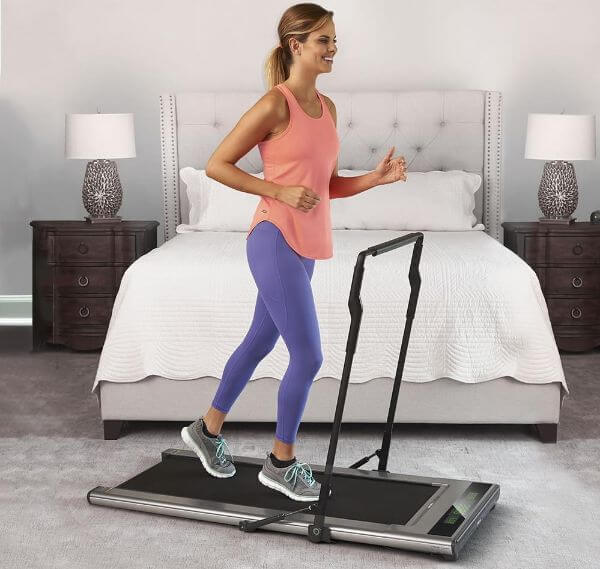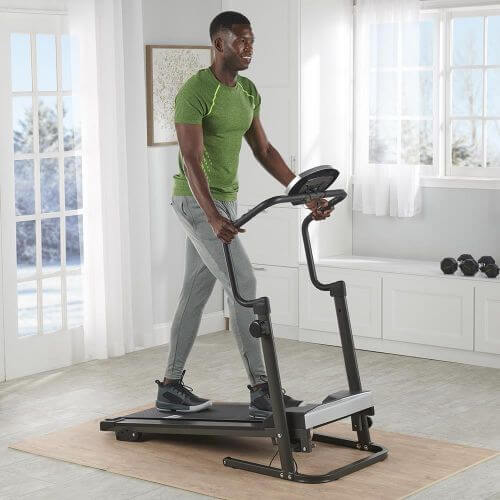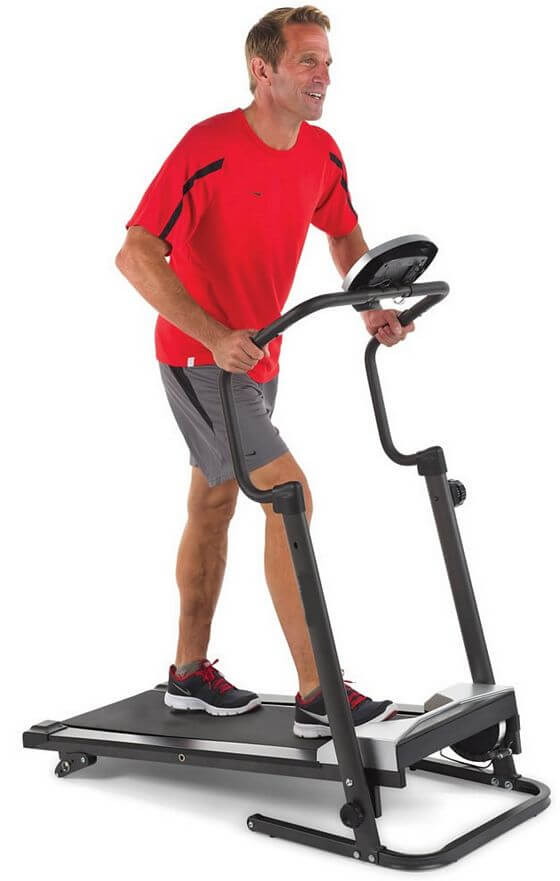If you’re thinking about choosing a treadmill for your home, here are five guidelines and 21 issues you might want to consider.
Table of Contents
Try A Treadmill If You’ve Never Used One
First, if you haven’t used a treadmill before, maybe you can try one out a local gym or ask a friend who has one if you can try theirs out. Some gyms will provide a free visit without having to join. See foldable walking pad!
Consider a Used Commercial Treadmill
Second, there are often a lot of used treadmills for sale and you might want to consider starting with a used one from a gym. Gyms occasionally sell older models when they’re upgrading, and some used commercial treadmills might be better than some new home treadmills.
After COVID-19, a lot of gyms might even be selling some of their newer models as they space them further apart or go out of business.
Consider a Used Home Treadmill
Third, you can also often find used home treadmills for sale by owner for very low prices. Why do people sell their home treadmills if they’re still functional? I suspect it’s often because they bought theirs with the best of intentions of using it regularly, and maybe they used it a lot of first, but after a while they stopped using it and it just became a waste of space.
If there’s a chance this might happen to you, that’s a great reason to get a cheap used treadmill as your first treadmill, then if you stop using it, you won’t have wasted as much money. If you do use it, you’ll have proven to yourself that you’ll also get good use out of a better, newer treadmill with more features.
Consider an Expensive Treadmill
Fourth, there are some reasons why you might want to choose an expensive treadmill: to get more features, to get better features, it may last longer, it may support heavier users, it may be more aesthetically pleasing, and so on.
See Ultra Slim Folding Treadmill (Under Bed)

The 21 issues I’m going to cover in a moment will give you more ideas.
Least Expensive Treadmill Meeting Your Needs
My fifth and last guideline is to create a master list of what you need a treadmill to do and what you want your treadmill to do, and then get the least expensive treadmill that will do what you need and want.
If you can’t afford one that does everything you need and want, you’ll need to decide which of your needs and wants to give up for what you’re able and willing to pay.
Now here are 21 issues to consider to create your needs & wants master list:
1. How fast it will go?
What’s the fastest you walk or run now? Are you going to try to increase your top speed?
Your treadmill’s top speed should ideally be faster than you ever expect to go. Lots of treadmills designed for walking only will go 4-6 mph (6.5-10 km/h), most treadmills for running will go 10-12 mph (16-19 km/h).
To get one that’ll go faster than 12 mph, you might have to get a new or used commercial treadmill.
2. How much it will incline or decline?
What’s the steepest you want to walk or run uphill and downhill?
Some inexpensive treadmills don’t provide changing inclines, but most medium or better quality treadmills at least provide some incline.
I think one reason a lot of people like treadmills with high inclines is because they can walk uphill and burn as many calories as they do when running flat, but with less stress on their knees. High inclines are also very good for athletic training.
3. Which built-in programs does it have?
All treadmills will let you decide when and if to change the speed and incline, but some provide programs that will change those for you for various reasons.
For instance, if you have a heart rate monitor connected to the treadmill, it can increase or decrease the speed to keep your heart rate in a specific target range.
The most advanced treadmills offer pre-programed, semi-randomized, adaptive, and custom workouts, plus a variety of standardized performance tests.
4. What exercises can it do besides walking and running?
Every treadmill offers walking, and most offer running, but some also provide strength training options, such as using your legs to push against resistance provided by the motor.
The Technogym Skillrun even offers a belt that connects to the treadmill’s frame so the user can use their legs to pull against resistance from the motor.
5. Does it have entertainment?
Boredom can kill your desire to work out. You can always watch a nearby TV or something to fight off boredom, but I think having a wide variety of entertainment options built into a treadmill’s console can help motivate you to get on and get going more than non-built in options.
6. What performance feedback does it provide?
Having lots of feedback is extremely valuable to me, and it might be to you, too. I like to set milestones in my mind and keep going until I reach one, then pick another one to try to reach.
This can be things like the time elapsed since I started, the distance I’m walking or running, or the calories I’m burning.
The more feedback it’s got, the more milestones I have to choose from.
7. Will it track your performance over time?
That can help provide long-term motivation to keep up your workouts. For some people, that might make the difference between whether they keep using their treadmill or whether it just collects dust.
8. Does it have classes?
At least one treadmill brand encourages you to exercise with groups of other people at the same time over the Internet, for a monthly fee.
This can provide a lot of motivation for some people, help avoid boredom, and help them push their exercise level of effort higher than it might be otherwise.
9. Does it have coaching?
Treadmills that have a camera built into the console can let a remote coach watch you and encourage you to keep going during your workouts.

10. How easy is it on the knees?
Many treadmills offer a flexible deck that bends a little when you’re walking and bends more when you’re running, to reduce the shock of each step to your knees.
This may make walking and running on that kind of treadmill safer than walking or running outdoors.
11. How much weight will it bear when walking?
What’s the highest weight among everyone who might use your treadmill?
Your treadmill needs to support a user that weighs at least that much, because if the motor isn’t powerful enough, it may not turn the belt, or it might overheat the motor or other parts until it breaks.
12. How much weight will it bear when running?
Turning a tread at a certain speed requires more power when someone is running, rather than walking, so if you or anyone else is going to run on your treadmill, you should take this into account.
For example, my old Precor commercial treadmill would support a 500 lb. (225 kg) person walking, but only a 350 lb. (160 kg) person running. Home treadmills will probably have lower limits.
13. How long will it last?
Commercial treadmills designed for gyms are built more ruggedly than home treadmills.
They generally use thicker, heavier frames, and have more powerful motors. This may not be important if you’re lightweight or won’t use your treadmill every day, but if you’re a heavyweight and use your treadmill every day, a treadmill designed for typical home use may not last long.
Likewise, if you try to start a low-budget gym using home treadmills, they may quickly fail when used by multiple people all day every day.
14. What does the warranty cover, and for how long?
Will the warranty provide someone to come to your house to repair the treadmill?
If not, are you prepared to pay a repairman to come to your house?
15. How much space does it take up?
Some walking-only treadmills take up relatively little space, while many treadmills take a lot of space. And if you’re going to run on it, it’s safest to have six feet (1.8 meters) behind your treadmill in case you fall and it tosses you off the back.
It’s probably better to land on the floor than on furniture or other exercise equipment.
Commercial treadmills can also be tall. The running surface on my Skillrun is about 12 inches (30 cm) off the floor, which could be a problem for a tall runner with a low ceiling.
16. Does it fold to reduce space when not in use?
You can easily fold up the deck on many home treadmills, and it will take about half the space it needs while in use. That can be very nice if your treadmill is in a room without a lot of space.
Commercial treadmills, however, with their heavier, stronger frames, are not only bigger, they also won’t fold.
See Easy Storage Compact Folding Treadmill With Incline

17. How hard will it be to get it to your home?
If you buy a new treadmill, will they deliver it?
If you buy a used one, it’ll be up to you to get it home. You’d better check the size and weight before you buy it, and if you’re planning to borrow a friend’s truck, ask them before you buy it, not after.
If you’re going to move a commercial treadmill, you may need a small army of helpers.
18. Ease of assembly/reassembly
How hard is it to assemble if new, or reassemble if used and it’s been partially disassembled to get it home?
If you’re buying a new treadmill, consider asking if you can pay extra to get it assembled in your house for you.
See Best Home Exercise Equipment For Beginners & Weight Loss
19. What kind of electrical circuit does it need?
Most home treadmills in the U.S. will work on a common 15 or 20 amp 120-volt circuit, but it might require a dedicated circuit.
Can you unplug everything else on the circuit the treadmill will use? Will you need to have an electrician put in an extra circuit? Does the electrical breaker box in your house have the extra capacity for another circuit?
Many commercial treadmills require a 30 amp 240-volt dedicated circuit. Does your breaker box have that much capacity to spare?
If new wiring has to be run, how far is will the treadmill be from the breaker box, and how much wall surface with have to be replaced to run new conduit?
On the other hand, a manual treadmill, also known as a non-motorized treadmill, or motorless treadmill, doesn’t have a motor and doesn’t need electricity, except for a battery to power a simple feedback display.
20. How loud is it?
Most treadmills aren’t very loud, but I think most commercial treadmills tend to be a little louder than most home treadmills. Most treadmills are louder the faster they go, and belt-and-deck treadmills tend to be louder than slat-belt treadmills.
If you want to run fast on a treadmill, and the noise bothers someone else at home, you might want to do your treadmill workouts when they’re not nearby.
21. How nice does it look?
Maybe you don’t think this is important, but I think I’m more likely to use my treadmill regularly if it looks nice.
I think mine is elegant, and it makes me happy to look at it, which lowers my resistance to changing clothes and getting started working up a sweat.
I hope this helps you figure out which treadmill is right for you.
Remember, you don’t have to have a treadmill to walk, run, or sprint, so whether you have one or not, keep walking, running, or sprinting!
Is Rowing Better Than Running?